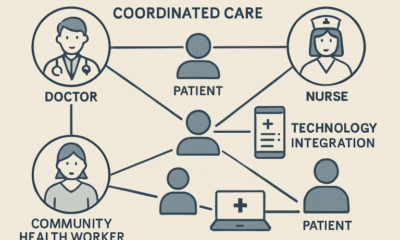Health
Beyond Talk Therapy: Exploring Non-Traditional Approaches to Depression

Transcranial Magnetic Stimulation (TMS)
For individuals who haven’t found relief through traditional talk therapy or medication, exploring non-traditional approaches to treating depression can be a meaningful next step. Depression is complex, and while treatment and medication are effective for many, others may experience limited progress or unwanted side effects. In such cases, alternative therapies like Transcranial Magnetic Stimulation (TMS) are gaining attention as viable options.
TMS uses targeted magnetic pulses to stimulate areas of the brain associated with mood regulation, offering a noninvasive, medication-free approach. It’s typically considered when other treatments haven’t provided the desired outcome. Many people are turning to this technique after years of managing symptoms with limited success. For those curious about how it works and who it may help, it’s essential to get the facts about TMS therapy for depressionfrom reliable sources. Understanding the science and clinical evidence behind it allows for more informed and confident mental health decisions. While not a universal solution, it has shown promise in treatment-resistant cases. Discussing it with a mental health professional can help determine whether it’s suitable. Continued research also suggests expanding potential uses of TMS beyond depression.
Ketamine Therapy
Ketamine, originally developed as an anesthetic, has in recent years burst onto the scene as a revolutionary, rapid-acting treatment for major depressive disorder—particularly for individuals who are resistant to standard antidepressant medications. Unlike most antidepressants, which can take weeks to show benefit, ketamine infusions or nasal sprays often bring measurable symptom relief within hours to days. This rapid impact is especially valuable for people experiencing severe depressive episodes or suicidal ideation, offering hope at times when other approaches have failed. Ketamine’s mode of action on the brain is distinct from conventional antidepressants, targeting glutamate neurotransmitter pathways rather than just serotonin or norepinephrine. Although it must be delivered in specialized clinical settings due to potential side effects and the need for careful monitoring, ongoing clinical studies demonstrate ketamine’s impressive potential to change lives when administered responsibly.
Mindfulness and Meditation
Mindfulness and meditation offer an accessible, empowering set of tools for breaking the destructive cycle of negative thoughts that drives and worsens depression. These practices center on fostering full awareness of the present moment, intentionally observing experiences, thoughts, and feelings without judgment or avoidance. Techniques include deep breathing exercises, guided imagery, mindful walking, and progressive muscle relaxation, each aimed at calming the mind and soothing physical tension. Programs like Mindfulness-Based Cognitive Therapy (MBCT) skillfully blend traditional cognitive therapy strategies with systematic mindfulness skills, and have been demonstrated to reduce relapse rates among people with recurrent depression. Notably, the skills learned through mindfulness and meditation are sustainable, portable, and can be practiced independently for a lifetime—providing ongoing support for emotional resilience and stress management.
Art and Music Therapy
Creativity can serve as a profound pathway to healing, especially for individuals who struggle to articulate their innermost feelings verbally. Art therapy encourages people to express and explore thoughts, experiences, and emotions through creative processes like drawing, collage, sculpture, or painting, guided by trained art therapists who facilitate safe self-discovery and insight. Similarly, music therapy encompasses a spectrum of possibilities: from simply listening to calming or energizing tunes, to creating music or writing songs that illuminate and transform emotional pain. Engaging in creative activities helps make sense of complex emotions and builds confidence, supports self-esteem, and enables powerful emotional breakthroughs—even when words fail. Increasing evidence shows these therapies can play a vital role in reducing symptoms of depression and enriching participants’ sense of well-being and purpose.
Exercise and Physical Activity
Routine physical activity is consistently recognized as one of the most reliable lifestyle interventions for boosting emotional well-being and brain health. Exercise catalyzes the release of endorphins—natural chemicals the body produces to combat pain and stress—resulting in tangible improvements in mood, relaxation, and outlook. Importantly, deriving the mental health benefits of exercise does not require extreme training or athletic ability; something as simple as a brisk daily walk, gentle yoga, stretching, swimming, or even dancing can provide substantial mental and physical rewards. Besides mood enhancement, exercise helps regulate sleep, increase energy levels, improve cognitive function, and build self-confidence—all crucial elements for managing and overcoming depression. No matter how modest, regular movement fortifies the foundation for lasting emotional health and resilience.
Acupuncture
Acupuncture, a practice rooted in ancient Chinese medicine, involves delicately inserting thin needles into specific points on the body to balance energy (qi) and support overall wellness. Although its mechanisms are still being explored, research increasingly suggests that acupuncture can reduce depressive symptoms, perhaps by influencing neurotransmitters involved in the body’s stress response and mood regulation. Treatment is typically individualized, with practitioners modifying their approach to meet each patient’s needs and experiences. Some people find acupuncture sessions deeply relaxing, reporting increased vitality, reduced anxiety, and enhanced emotional balance—sometimes using acupuncture on its own, and often in combination with traditional therapies. While further large-scale studies are needed, many individuals view acupuncture as an essential complementary resource on their path to healing.
Animal-Assisted Therapy
For many, the presence of a therapy animal brings comfort, unconditional affection, and a sense of connection that can make an enormous difference in the experience of depression. Animal-assisted therapy formally incorporates animals—such as dogs, cats, rabbits, or horses—into therapeutic settings to catalyze emotional healing and personal growth. Interacting with animals has been shown in studies to trigger the release of oxytocin, a hormone linked closely to emotional bonding and trust, while simultaneously reducing cortisol and other biological markers of stress. The simple acts of petting, playing with, or walking a therapy animal can help soothe anxiety, elevate mood, and encourage greater engagement in social activities. Animal-assisted interventions can be easily tailored to individual preferences. They may represent a gentle, effective complement to more traditional talk therapies and medications, particularly for those challenged by feelings of isolation or hopelessness.
























